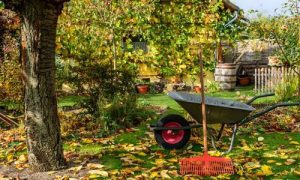
It is officially Autumn meaning darker, colder evenings and gorgeous autumnal leaves. With this n…
Whether you are out in your garden to plant spring and summer flowers or vegetables or braving the colder weather to create a winter wonderland of plants and flowers over Christmas, you want to ensure you prepare the soil. Soil preparation is just as important as any other part of gardening for successful planting. With this in mind, how do you prepare soil for planting?
Soil preparation is made up of several stages:
At Bonsai Landscapes, we have been helping homeowners create gorgeous outdoor spaces with colourful flower arrangements and delicious homegrown fruit and vegetables since 2012. Our team are highly trained and know the art of soil preparation for successful planting.
In this blog, we explore the several stages of soil preparation so that you can nail it and reap the rewards.
Weeds are pests for a flourishing gardener. They draw nutrients from the soil, meaning your plants are deprived of the nutrients they need, impacting their growth and allowing the unappealing weeds to thrive.
So, it is important you start by removing all the weeds in your plant bed soil.
Along with this, you should keep an eye out for debris that might hinder plant growth.
Top Tip: Use tools such as a hoe or weed puller to make this step easier. Also, don’t forget your kneeboard for comfortable kneeling while you do it.
Plants can require a specific soil condition for optimal growth.
Understanding the pH level of your soil because it affects the nutrients of your soil. So, how do you prepare soil for planting by testing this?
If the pH is too high (alkaline) or too low (acidic) it can limit the availability of essential nutrients, which could mean poor plant growth, weak root development and low resistance to pests and disease.
There are two ways you can test the pH of your soil:
If your soil doesn’t have a balanced pH level, there are a number of things you can do to combat it and prepare it for planting.
Tips to raise the pH level if it is too acidic:
How to lower soil pH if it’s too alkaline:
Your next step is to loosen the soil. This is because compact soil can prevent roots from settling. Plus, it can prevent air circulation and water drainage.
You might find you do this step as you sort out the soil pH level. If you don’t it is important to do it as a separate step rather than just miss it out.
By loosening up your soil, you will create space for roots to spread and settle so they can get the best nutrients to grow.
Loosening the soil also creates gaps in the layer, which allow water to seep through so that it doesn’t pool in the ground. Ensuring the water can move throughout the layer, filtering through to the lowest parts, ensures the roots don’t drown.
Just use a garden fork or tiller to break up the compacted soil and loosen it.
Top tip: Be careful of over-tilling as this can disturb beneficial microorganisms within the soil.
With the soil loosened and pH levels balanced, you should add organic matter.
This includes:
Each of these types of organic matter has components that enrich the soil, helping to boost nutrient content, improve soil structure and encourage beneficial organisms like earthworms.
Fertiliser adds extra nutrients to your soil, similar to organic matter.
But any old fertiliser won’t do for your soil preparations. You will need the right one for the needs of your soil.
There are two types of fertilisers:
When spreading fertiliser, you will need to follow the instructions and application rates as suggested.
Top tip: Sandy soils might need more frequent fertiliser because of leaching, but clay soils retain nutrients, so can go longer periods of time between fertilising.
Levelling soil is often overlooked, but it is actually an essential part of how to prepare soil for planting.
This step ensures that even planting and proper water distribution because uneven soil can lead to problems that impact the health and growth of your plants.
Levelling is a fairly easy and simple process, as you can just pull a garden rake across the surface of the soil to smooth out mounds and dips.
Once you have levelled the surface, you will need to water the soil before you think about planting anything.
This will help settle newly levelled soil, which means it has enough moisture for germination and can make it easier to plant.
There we have it, a comprehensive answer to “how to prepare soil for planting.”
Preparing soil is a six-stage process that includes:
If you follow these steps, you can look forward to successful planting so your garden will be full of vibrant flowers and plants.
Need a little help with your garden? Don’t worry, we are on hand to help!
At Bonsai Landscapes, we have a team of gardening experts who have spent years learning how to prepare soil to create the perfect conditions for planting.
We are also experts at matching a selection of plants with your soil and garden conditions, so if you can prepare your soil but struggle to pick the right plants to thrive in your garden, we can create a planting and bedding plant package for you. These will be bespoke to your soil and garden conditions, so you can be confident that with the right care, they will grow happy and healthy.
Of course, as a gardening company, we can also help you maintain your garden year-round.
Want to learn more about our services? Call us on 07477 968735 or complete our online contact form, and we will give you a callback.
Recent Posts
2025 © Bonsai Landscapes